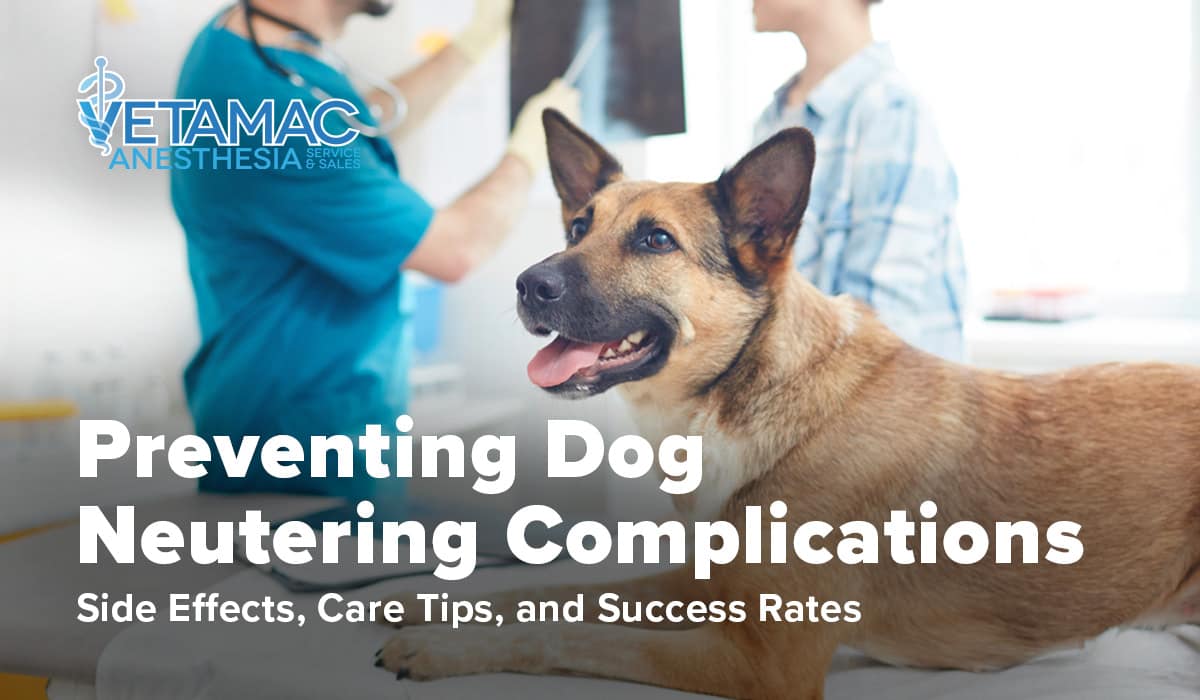Veterinary Specialist Articles
Call Us
1 800 334-1583

Canine castration (dog neutering) is a routine surgery performed by small animal vets. While complications are rare, proper technique and understanding risk factors are crucial for the best outcome.
A routine dog neuter, typically performed in dogs with both testicles descended, is commonly done through a prescrotal incision. This incision is made just cranial to the scrotum and extended long enough to allow for easy exteriorization of the testicles.
An alternative, less common castration technique involves a single scrotal incision near the median raphe, which can reduce surgical time. Though scrotal incisions are less frequently used by general practitioners, they are considered a safe and effective method for both pediatric and adult dogs. Complication rates for both techniques are generally similar.
After the skin incision is made—whether scrotal or prescrotal—the surgeon must decide between performing an open or closed castration.
Unlike ovariohysterectomy, routine dog neutering (in non-cryptorchid dogs) generally carries a low risk of significant intraoperative complications. Issues like slipped pedicles, nicked spleens, and other complications common in ovariohysterectomy are rare during standard castrations, and even less frequent during cryptorchid castration.
The most significant intraoperative risk during routine dog neutering is the inherent risk associated with anesthesia.
Several studies have examined the likelihood of complications or mortality during anesthesia in pets. A 1998 study found that 2.1% of anesthetized dogs experience anesthetic complications, with a mortality rate of 0.11%.
Although anesthesia-related risks are generally low, steps should be taken to minimize these risks. Elective procedures like neutering should be performed on healthy dogs, with any illnesses corrected prior to anesthesia. Proper equipment and safe anesthetic protocols are essential, with customized protocols for each patient using a balanced anesthetic approach.
Anesthesia monitoring tools, such as pulse oximetry, blood pressure measurement, capnography, and electrocardiography, should be used for all anesthetized patients. These tools help detect and correct anesthesia-related issues early, ensuring a safer procedure.
Complication rates associated with routine canine neutering vary, ranging from 0% to 32%. Younger dogs are often at higher risk for complications. Many mild complications likely go undetected, as pet owners may monitor them at home without seeking veterinary care.
Common post-surgical complications following dog neutering include:
Self-trauma to the surgical site is another common concern, as it can both cause and exacerbate the complications listed above.
Surgical site dehiscence is most commonly caused by self-trauma. The risk of dehiscence can be reduced with proper surgical technique and careful post-surgical care.
To minimize the likelihood of dehiscence, avoid placing sutures too tightly when closing the incision. Tight sutures can cause pain and discomfort, increasing the risk of self-trauma and opening the incision.
An Elizabethan collar (e-collar) is also recommended during the recovery period to prevent the dog from causing self-trauma to the surgical site.
Scrotal hematomas are often a mild complication following dog neutering and typically resolve on their own over time. However, in some cases, the hematoma can grow large enough to interfere with blood flow in the scrotum, leading to necrosis of the scrotal skin and potentially requiring scrotal ablation.
Scrotal hematomas may result from bleeding in the testicular artery or within the scrotum itself. At the first sign of a hematoma, ice packs and non-steroidal anti-inflammatory medications (NSAIDs) can be used to reduce swelling and slow the progression of the condition.
Capillary bleeding may occur within the first few hours after dog neutering. If this happens, applying a light scrotal wrap to gently apply pressure to the incision can help control the bleeding. The wrap can be removed after a couple of hours, helping to minimize post-surgical bruising around the incision site.
Hemorrhage following dog neutering is typically caused by slipped ligatures resulting from insecure placement. To reduce the risk of this complication, several techniques can be employed, such as:
If significant bleeding occurs from the spermatic cord, signs of anemia such as pale gums may be observed. In severe cases, it may be necessary to open the abdomen to locate the source of the bleeding. Once identified, the vessels should be re-ligated to stop the hemorrhage.
The infection rate associated with spay and neuter surgeries is estimated to range from 2.2% to 5.7%, which is comparable to the infection rates seen in other elective surgeries.
Several factors can increase the risk of surgical site infections in pets undergoing neutering or similar elective procedures. These factors include:
To reduce the likelihood of post-surgical infections, several preventive measures are recommended: optimizing the pet’s health before surgery (e.g., diagnosing and treating underlying medical conditions), ensuring a sterile surgical environment, employing proper surgical techniques, and utilizing active warming methods to prevent hypothermia during the procedure.
Although neutering is a common procedure with a relatively low risk of significant complications, it is important not to become complacent. Patient selection, pre-surgical evaluation, effective anesthetic protocols, surgical asepsis, surgical technique, and owner compliance all play an important role in the success of this procedure.